History of Occitania, part 2
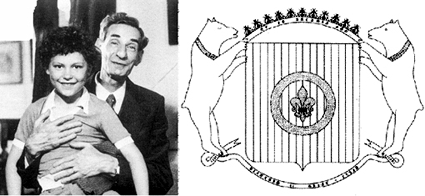
Descandants of the Merovingians?
In the 20th century there was a Frenchman who claimed that he descended from the Merovingian Dynasty, Dagobert II to be precise. Whether this is true or false is not important to us. However, by studying the pieces they played with, we understand that these pieces could still be of value to us. For example, the family coat of arms made by Pierre Plantard de Saint Clair is interesting. It shows two bears and 11 bees, together with the phrase: "Et in Arcadia Ego". The two bears are a hint towards Arcadia and the bees are Merovingian/Visigoth.
It is clear that the Visigoths have a very interesting heritage which could go back as far as the Minoans and Phoenicians over several millennia. But it is also a fact that the Merovingians found themselves to be of a higher and purer descent, due to their claim to the royal bloodline of Benjamin. The Carolinians preferred to marry Merovingian princesses to mix the bloodline with their own royal bloodlines. And this would lead to the interesting bloodlines of the many noble families of Europe, as a lot of 'blue blood' (grapevine) would flow through their veins.
Of course we now know very well that bloodlines aren't a guarantee for the quality of a human being. Today we need to look at the protection of a certain culture that valued science, mysticism, peace and the reunion with the female principle of God, Mother Earth, the Mother Goddess. We already found out in the Renaissance that it is all about the purification of the soul (alchemy), but in spite of this "New Birth" of mankind, we are still running around in diapers. Humanity is suffering from severe growing pains and needs to fall several times before we can find our balance to stay upright.
THE KINGDOM OF SEPTIMANIA (509-719)
After the Battle of Voullè in 507, when the Merovingian (Frankish catholic) king Clovis I (King of the Franks) had beaten the Visigoths, the Visigoth prince Amalric was taken to Spain for his safety. Aquitainia was now occupied by the Merovingian Franks, and Septimania would go to Amalric's grandfather Theodoric the Great, king of the western empire. In 509, Theodoric founded the kingdom of Septimania with Narbonne as its capital. The regent he appointed was the Ostrogoth Theudis. Part of the Ostrogoths had joined the Visigoths in France and Spain at that time. In 522, Amalric was old enough to reign and was crowned king of Septimania. When Theodoric died 4 years later, Amalric was king of Septimania and the rest of the Visigoth realm. He married Clotilda, the daughter of Clovis, to create an alliance between the Visigoths and Merovingian Franks. This way he would ensure a double bloodline and thus a greater claim to the throne. But, as the Visigoths were still Arian christians at that time and the Merovingians had adapted to the catholic christianity, this wasn't a smart move. The difference in religions would finally get him killed in 531. After his death, Septimania would be ruled by Visigoth and Merovingian noblemen.
After the defeat of the Visigoth king Roderik in 711, the Moors entered Septimania in 719. After a few bloody wars they would finally retreat behind the Pyrenees and back into Spain, but in the mean time, Septimania was devastated. The king of the western empire installed Gothic noblemen to rule the old kingdom and this was a period in which many monasteries were built. After the death of Charlemain, Septimania was also called "Gothia" because of the many Visigoths that still lived in the area, and because it was ruled by Visigoth marquises. Later, the area would be called Roussillon, and names like Septimania and Gothia would no longer exist.
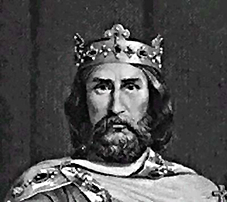 THE CAROLINIANS
THE CAROLINIANS(751 tot 987)
Pepin II of Herstal (635 or 640 - 16th December 714) was major domo of Austrasia, Neustria and Burgundy (Burgundy from 680 to 714) and eventually he would gain more and more power in the Frankish realm. The Merovingian king Theuderic III tried to fire him from his post as major domo, but was beaten in Tertry in 687. Pepin then became the real leader of Austrasia and kept the other Frankish kingdoms under his control. His children would also be major domo, but his grandson, Pepin the Short, would become king in 751.
Charles Martel (23rd August 676 - 22nd October 741) was major domo in the Frankish realm. He was also born in Herstal in today's Wallonia (Belgium). Charles was the bastard son of Pepin II and his concubine Apaida. Charles Martel is most famous for his victory at the Battle of Poitiers in 732, which is seen as the 'rescue of Europe from the Arabs'. Martels Frankish army would beat an Arab army which tried to spread the islam. Although the Arabs would not be able to conquer all of Europe, they did succeed in occupying the greater part of Southern France and Iberia (Spain and Portugal). Although it would take two more generations before the Arabs were forced back over the Pyrenees, this victory would change the opportunity of the Arabs to the benefit of the Franks, and it would also lead to the unification of the Frankish realm under Charles Martel.
In the next decennium, Charles lead the Frankish army against the eastern duchy of Bavaria and Alemania, and against the southern duchies in southern France. He intervened in the conflict with the Saxons, with limited success, but the real victory over the Saxons would be for his grandson Charlemagne. Charles Martel died on 22nd October 741 in Quirzy, in what we now know as the department of Aisne in France. He is still buried in the Saint-Denis-basilica in Paris. Charles was succeeded by his sons Carloman, Pepin the Short and Grifo.
Pepin the Short, son of Charles Martel, was the first king of the Carolinian Royal House, the dynasty that would exist from 751 to 987. After the death of Pepin in 768, his realm was divided between Charlemain and his brother Carloman. Carloman, however, died on 5th December 771, and Charlemagne would then become king of the entire Frankish realm. The far south-east of France was still mainly in the hands of feudal lords, for instance the counts of Toulouse and Barcelona with powerful counts such as the counts of Razes and the Trencavels of Carcassonne as their vassals. Many of these lords were related to the Visigoth and Merovingian nobility.
THE FEUDAL STATES OF THE LANGUEDOC
The Visigoths mainly lived in the southeast of France and Spain, while the Merovingian Franks would rule a large area between Belgium and the Pyrenees. The last Visigoth king we know is Roderik, who died in 711 trying to beat the Moors. The last Merovingian king we know is Childeric III (743-751). And after them we enter the Carolinian period discussed above. Charlemagne, however, kept dukes and counts and marquises to rule the various areas and in southern France the Visigoth and Merovingian nobility still ruled under Charlemagne.
Sigisbert VI
In the 9th century there was a Merovingian count called Sigisbert VI (820-885) who called himself Ursus. He was the count of Razes, an area in the Languedoc which would at this point contain the counties of Toulouse, Barcelona and Rhedae.
Sigisbert is a direct descendant of Merovech and predecessor of Godfroy de Bouillon, a very important person during the Crusades to the Holy Land. The urge to conquer Jerusalem so suddenly after 1000 years does attract attention. There is a small possibility, that this urge was stimulated, provoked, by descendants of the tribe of Benjamin, who, through the Merovingian nobility, were now looking for proof of their royal descent, which would be hidden in archives in the tunnels of the Templemount in Jerusalem. It is possible, even probable, that the elite top of the Knights Templar were themselves descendants of the Merovingians. This bloodline would have travelled north with Sigisbert VI. There are family ties with the house of Luxemburg and Champagne, who may descend from Sigisbert VI. In the past it has been tried again and again to create an Hermetic State based not on religion but on science and knowledge, mysticism and peace. Sigisbert VI is probably one of those who tried. With doing such, he made himself an enemy of the Holy Roman Empire. Even the Knights Templar would suffer the same fate.
Sigisbert made use of the chaos that took place when Charlemagne died. He was crowned king in Nimes in 877. However, he lost his battle with Louis II of France and had to flee to Reims. His descendants may have went to Brittany and England. After his death, his body would then have been taken to England to be buried there.
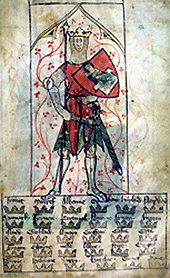 Some historians think that this Ursus was the Arthur of legend. Arthur also means bear (Arth = bear in Welch) and his history does resemble Ursus' life story quite a bit. Like Sigisbert VI, Arthur battled to unite kingdoms to create a glorious realm in which people would live together in peace. The search for the Grail embodies the search for the missing female aspect and the urge to reinstall the Mother Goddess as a counterpower to the patriarchal Holy Roman Empire. The Round Table with the 12 knights symbolises the Polestar at the tail of Arcas, around which the 12 Zodiak signs move. It could be a hint towards Arcadia and the ancient navigators. After Arthur's death, his body was brought to an island called Avalon. It is possible that Avalon is the old abbey in Glastonbury on the island of Albion (now called England). The grave of Arthur was found by monks at Glastonbury Abbey, which itself was founded in the first century, according to legend by no one else than Joseph of Arimathea.
Some historians think that this Ursus was the Arthur of legend. Arthur also means bear (Arth = bear in Welch) and his history does resemble Ursus' life story quite a bit. Like Sigisbert VI, Arthur battled to unite kingdoms to create a glorious realm in which people would live together in peace. The search for the Grail embodies the search for the missing female aspect and the urge to reinstall the Mother Goddess as a counterpower to the patriarchal Holy Roman Empire. The Round Table with the 12 knights symbolises the Polestar at the tail of Arcas, around which the 12 Zodiak signs move. It could be a hint towards Arcadia and the ancient navigators. After Arthur's death, his body was brought to an island called Avalon. It is possible that Avalon is the old abbey in Glastonbury on the island of Albion (now called England). The grave of Arthur was found by monks at Glastonbury Abbey, which itself was founded in the first century, according to legend by no one else than Joseph of Arimathea.Between the 9th century and the year 1271, the noble families of the Languedoc would rule southern France. There was a duchy of Aquitaine, the counts of Toulouse and Foix and the count or king of Barcelona (later called Catalonia). There was a lot of intermarrying between these families and they were really all related in some way to one another. This would stimulate peace and co-operation between the counties. To defend themselves against enemies such as the bandaleros, who sometimes came across the Pyrenees from Spain to plunder, large fortresses were built, of which Foix is an excellent example. Their wealth and prosperity was famous. Beautiful churches were built and monasteries were founded. It was a period of illumination, in which troubadours were singing political opinions freely and were most of all famous for their love songs. Pilgrims had to cross the south of France to reach Santiago de Compostela, where they found the holy relics of a man called James, apostle of Jesus.
According to Robert Eisenman, this James of Santiago could very well be no one else but James, the brother of Jesus. James was Jesus' successor in the first century, but was killed during riots. Several centuries later his relics were taken out of the sarcophagus and taken to Spain (then still part of the kingdom of the Sueves) and reburied. The sarcophagus of James has been found not long ago in Israel, and declared genuine. On the sarcophagus were the words "James, son of Joseph, brother of Jesus". The sarcophagus was, of course, empty.
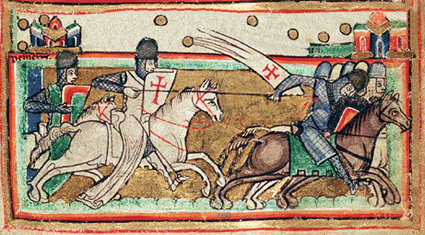
THE CRUSADES
In this period (11th, 12th and 13th century) people would take up the sword and fight against the Saracens in Palestine. These were the ages of the Crusades, in which bandits, lords, adventurers, outcasts and murderers would travel east to conquer Jerusalem. This city was an important symbol for christianity, and the islamic Turks who had the city in their possession, did not allow christian pilgrims in Jerusalem. It was decided that the city should be conquered and the pope summoned everyone who could handle a sword to 'take the cross' and make the long journey to Jerusalem. There were many noble families who would have their sons participate. About 80.000 people (children and women too!) would travel east in 1096 for the very first time, but hardly anyone came back alive. Many of such crusades would follow, and stronger armies would participate, and sometimes they succeeded in conquering Jerusalem and holding it for a while. During such times, a king of Jerusalem was chosen and pilgrims could travel to the holy sepulchre reasonably safe.
The Knights Templar
To protect this pilgrim road, the Order of the Temple of Salomon was founded in the year 1118. Their knights were sort of pilgrim bodyguards. These were strong men, well trained and many of these Templar Knights would also fight with the Crusaders. The Order of the Knights Templar was officially founded (according to Guillaume de Tyre) in 1118 by Hughes de Payen, a nobleman from the Champagne region of France. However, there are texts that the foundation could have been a bit earlier, as the bishop of Chartres wrote a letter to the count of Champagne in 1114, that he had understood that he would enter the Order on his journey to the Holy Land. It attracts attention that Hughes de Payen of Champagne is the one founding the Order. The bloodline of the Champagne nobility would go back to Sigisbert VI Ursus, heir to the Merovingian dynasty. When this bloodline would indeed go back even further to Benjamin, then Hughes de Payen could not let this opportunity to get to Jerusalem and search the Templemount for genealogical proof go by. It is clear that the Knights Templar searched the Templemount.
So, an elite top of the Knights Templar didn't join the fighting, but concentrated on other things like studying Arab culture, their religion, their knowledge like science and architecture, and to search and collect everything they could find, like christian relics, genealogical data, etc. All these items and facts were taken back to France, as they wouldn't ever leave them in a hostile situation. In a letter written by St. Bernard, protector of the Knights Templar, is written:
The work was done with our help, and the knights have been sent on a journey through France and Burgundy, under the protection of the count of Champagne, so that all measures can be taken against any interference from the Chruch or the public."
The Order of the Knights Templar was quickly becoming very rich, in spite of their vow to personal poverty. They owned large pieces of land all over Europe. Immediately after returning from the first expedition to the Holy Land, the noble family of Blanchefort which was allied to the Knights Templar, would buy pieces of land in the name of the Order in the area of Campagne-sur-Aude and Coustoussa, largely the area between Blanchefort, Pech Cardou, Bugarach and Bezu, 4 sacred mountains in between which is a beautiful valley. A man called Bertrand de Blanchefort was named as the 4th Grandmaster of the Order. The first pieces of chess had been placed.
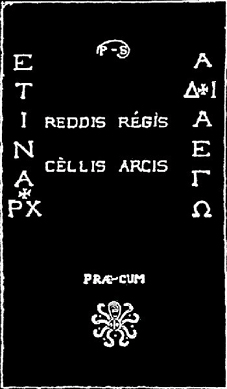 The last heir of the Blanchefort family died without male heirs and she told her family secret to abbè Bigou, a priest of the church La Madeleine in Rennes-le-Chateau. This was once the ancient Visigoth/Merovingian stronghold of Rhedae, where Dagobert II married the Visigoth princess Giselle de Razes. Abbè Antoine Bigou lived in a very dangerous time, and had to flee to Spain. He decided not to take the papers, that the Dame de Blanchefort had given him, with him to Spain, but to hide them in the church of Rennes-le-Chateau and leave a cryptic message to his successors. One of the cryptic messages had been carved in the tombstone of the Dame de Blanchefort. It said "Et in Arcadia Ego" in Greek letters and the words "Reddis - Cellis - Regis - Arcis", probably hinting the Arcadian heritage of the king who was laid to rest in the crypt underneath the church of Rennes-le-Chateau. When a century later abbè Saunière was renovating the derelict church, he found the documents that Bigou had left behind and this is where the enigma of Rennes-le-Chateau begins.
The last heir of the Blanchefort family died without male heirs and she told her family secret to abbè Bigou, a priest of the church La Madeleine in Rennes-le-Chateau. This was once the ancient Visigoth/Merovingian stronghold of Rhedae, where Dagobert II married the Visigoth princess Giselle de Razes. Abbè Antoine Bigou lived in a very dangerous time, and had to flee to Spain. He decided not to take the papers, that the Dame de Blanchefort had given him, with him to Spain, but to hide them in the church of Rennes-le-Chateau and leave a cryptic message to his successors. One of the cryptic messages had been carved in the tombstone of the Dame de Blanchefort. It said "Et in Arcadia Ego" in Greek letters and the words "Reddis - Cellis - Regis - Arcis", probably hinting the Arcadian heritage of the king who was laid to rest in the crypt underneath the church of Rennes-le-Chateau. When a century later abbè Saunière was renovating the derelict church, he found the documents that Bigou had left behind and this is where the enigma of Rennes-le-Chateau begins. N.B. Note the resemblance between the octopus on the gravestone next to Prae Cum (pray for us) and the Minoan octopus under the subtitle "Dan".
The Templars were gaining quite a lot of land, thanks to the support of countless noblemen. When noblemen would enter the Order, they would have to give the Order all their wealth and possession as a proof of their vow to poverty. Quickly, the Order became one of the worlds first bankers. Hungry for their wealth they would, however, soon become the kings prey. When it leaked out that the Knights Templar were trying to reconstruct the Visigoth Empire (they did use the Visigoth cross and the Visigoth seal of the knight on horseback) and through their heritage and genealogical proof found in Jerusalem had a claim to their own throne, the king and pope felt threatened and the Order had to be dissolved.
The Knights Templar are surrounded by mystery and valour. But still it is a fact that most of the armies that set out to the Levant consisted of fighters, Goths, Friezians, Franks, murderers and outcasts, who were told that murdering Arabs and help conquering Jerusalem and the Holy Land would be a ticket to heaven and forgiveness of all their sins. In reality, the Crusades were bloody wars from which survivors often returned home disillusioned, sometimes even emotionally disturbed.
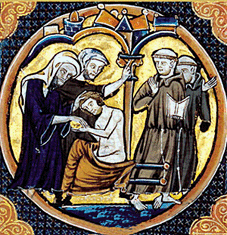 Crusade against the Cathars
Crusade against the CatharsEnlightenment, science and a mix of several religions created a glory time in the Languedoc-Roussillon. This glory time of illumination would not last long, because the knowledge and religions were opposite to the dogmas and teachings of the Holy Roman Church, and this meant that the latter felt threatened. Early in the 13th century, the first crusade against the Cathars and people of a different faith such as jews, set out to eliminate this threat. More on this subject, see the webpage on the Cathars.
The feudal lords tried to protect the Cathars and defended themselves against the groups of bandits and armies that entered the Midi. These lords would be called faydits, heretic lords. They resisted the barbaric force that the Church set upon them. However, in 1271, after the second crusade, they all had to surrender and the Languedoc-Roussillon would at last be officially French.
Unfortunately, the entire Midi was ruined. The population had dropped incredibly as countless people had died during the massacre of the crusades. Economy had crashed, and the population that still lived, was fighting to survive. Even the once so mighty order of the Knights Templar was dissolved and their leaders burned at the stake after they had been accused of heresy. However, they succeeded in making the textile industry florish and also by printing books and leaflets the economy would start to grow once again. This revival would last about 300 years.
THE WARS OF RELIGION
During the revival, the terrible wounds of the Cathar crusade are still fresh, and still they were hunting down people who thought differently and were a threat to the Church, like scientists and jews. The Church would really make life difficult and controlled the way people thought. It wouldn't be long before another road was taken to oppose the catholic belief system. The Wars of Religion broke out. In this period, protestantism was founded and people like Luther and Calvin tried to retranslate the Bible from the early Greek version, not the altered Latin version. These wars were quite bloody, even the people turned against one another. Many people were killed and a brotherhood called the Huguenots was founded which tried to resist the limitations of free will and free thought. Even during the Spanish occupation of e.g. the Netherlands hundreds of people were killed on the stake. The catholic Church had no mercy, and a storm of horrors blew through Europe.
THE RENAISSANCE
In the Renaissance the feudal system made room for a centralised state. The king had absolute power and this was also a fact for the Church. France was a powerful state and had lots of influence in Europe. However, the people were very unhappy. Everyone was still reviving from the black death, which had taken many lives, and then the 100 year war kicked them down again. Between 1550 and 1850 there was a 'little ice age', extreme cold winters killed many people, animals and crops. In 1789 the Revolution broke out, which lead to the end of the French monarchy. The first French consul was Napoleon Bonaparte, who tried to rebuild the French state. Slowly but surely, the higher educated class was getting interested in illumination, enlightenment, mysticism and science.
The Roussillon was still part of Spain (Catalonia) until the 17th century. In the 17th century, it was divided into Spanish Catalonia and French Catalonia (Treaty of the Pyrenees). French Catalonia was given the name Pyrenèes Orientales, better known as the Roussillon.
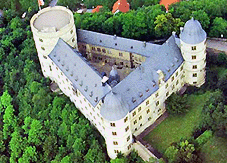 THE SECOND WORLD WAR
THE SECOND WORLD WAROpposite to the First World War, which is called the Grand Guerre in France and is still remembered every year, just like the millions that died in this war, much less attention is given to the Second World War. The Vichy government co-operated with Nazi Germany, but Charles de Gaulle and his Free French Troops opposed this. In 1942, Germany attacked France. There was a lot of resistance by de Gaulle and the French resistance called the Maquis. In 1944, just before the German withdrawal, the Germans would attempt one more time to conquer and keep the Languedoc by showering the Montagne Noire with parachutists. The Montagne Noire would form the northern border of the German occupied Languedoc. The reason behind this could well be Hitler and Himmlers urge to find the Grail. Especially Himmler was obsessed with the Knights Templar and with power, he wanted to collect as many relics in his castle at Wewelsburg. In the thirties of the 20th century, Himmler sent Grail expert Otto Rahn to the Languedoc to find the Grail. When Otto failed, he would die under suspicious circumstances (1939). During the war, German soldiers searched the entire area, from Montsegur to Rennes-le-Chateau. They found nothing.
THE PRESENT
Thanks to increasing tourism the area was opened up for visitors and the wine industry flourished. Circa 1900, however, the Languedoc was attacked by the dreaded phylloxera lice, bringing down the economy so much that poverty was high. After this event, the Languedoc quickly got over it and became one of the largest wine producing areas in France.
The Languedoc-Roussillon was divided in 5 departments:
Aude, Gard, Hèrault, Lozère and Pyrenèes-Orientales (also known as French Catalonia or Roussillon).
Because of the mild climate, the interesting sites and the beautiful nature, large numbers of tourists come to the Languedoc-Roussillon. Thanks to its history and the special place the Languedoc has had in it, the inhabitants still do not really feel part of France. The Languedoc has its very own Occitan culture. Place names are written in both French and Occitan, and even the language is still freely used. And there is still a gap between Paris and the Languedoc. For the Occitans the Languedoc-Roussillon is simply; the Land of Oc (Pays D'Oc).